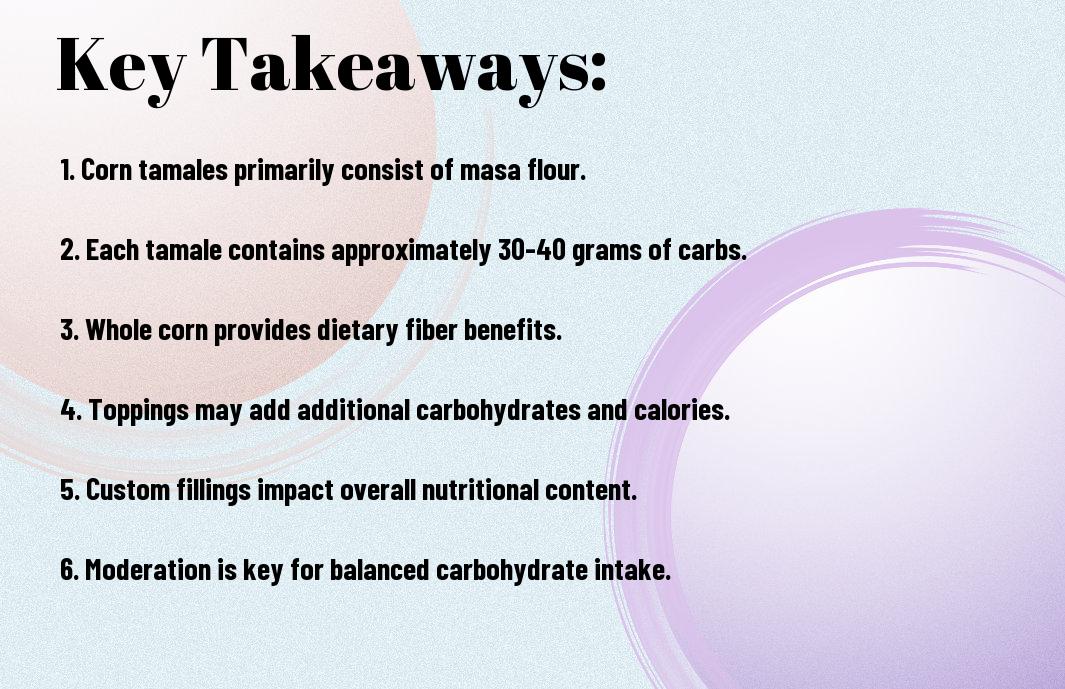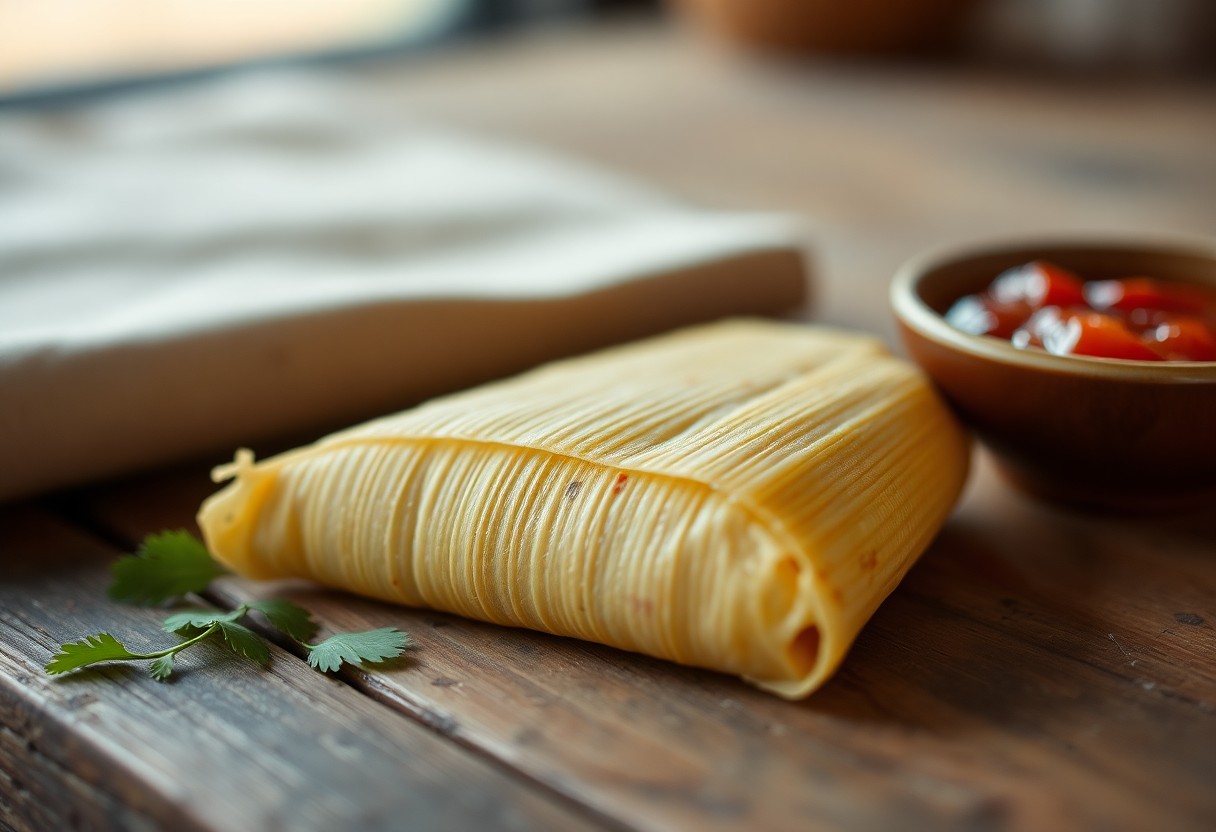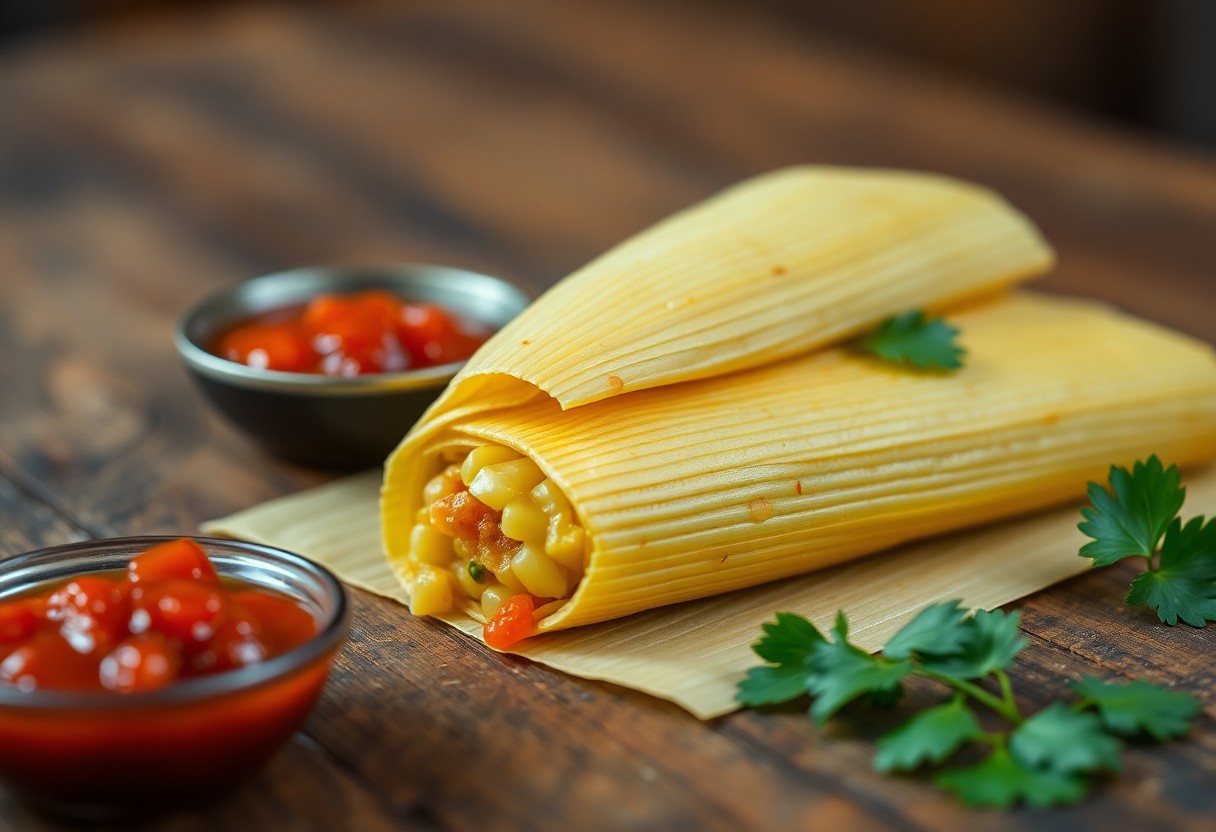Most people enjoy the delicious taste of a corn tamale, but being aware of its carbohydrate content is important for those managing their diets or health conditions. In this article, you will discover how corn tamales fit into your nutritional plan, including the average carb count, potential health benefits, and considerations for those with dietary restrictions. By understanding these factors, you can make informed choices that align with your nutritional goals.
Key Takeaways:
- Corn tamales are primarily made from masa, which is a corn-based dough, resulting in a significant carbohydrate content.
- The exact carb count can vary based on the filling and preparation method; adding proteins or fats can affect overall nutritional value.
- Portion size matters; enjoying tamales in moderation can help manage carbohydrate intake effectively.
What are Corn Tamales?
To understand corn tamales, you must know that they are delicious, traditional Mexican dishes made from masa (corn dough) and filled with various ingredients. Wrapped in corn husks, these soft packages are typically steamed to create a savory treat enjoyed by many. Whether filled with meats, cheese, or vegetables, they are a staple during festive occasions and family gatherings, offering a unique flavor and cultural significance.
Ingredients Overview
One of the foundational components of corn tamales is masa harina, a type of finely ground cornmeal. Alongside this, you’ll often find ingredients like water or broth, baking powder, and salt. Fillings can vary widely, including meats, cheeses, and even sweet variants with fruits or chocolate. Most tamales incorporate fresh corn husks for wrapping, which help retain moisture while cooking.
Traditional Preparation Methods
Around the world, traditional tamale preparation reflects cultural and regional variations. The masa is typically mixed with lard or vegetable shortening to achieve the perfect consistency and flavor. Filling is then placed on a spread of masa, rolled, and wrapped tightly in corn husks, which are important for steaming. Once assembled, tamales are carefully arranged in a steamer pot, ensuring they maintain their moisture and flavor during cooking.
In fact, the steaming process is important for achieving that tender texture you love in tamales. Traditionally, tamales are made during communal gatherings, where family members join together to prepare and cook them, creating a bonding experience. Different regions may add their twist, like using spices or local ingredients, lending each tamale a unique flair. Overall, this cherished practice not only provides a tasty meal but also a rich cultural heritage passed down through generations.

Carbohydrate Content in Corn Tamales
Clearly, understanding the carbohydrate content in corn tamales is important for making informed dietary choices. A standard corn tamale generally contains a significant amount of carbohydrates, derived primarily from masa (corn dough). The overall carbohydrate content can vary depending on the size and additional ingredients, but it’s important to recognize how this affects your daily intake.
Types of Carbohydrates
After examining the types of carbohydrates present in corn tamales, you might find the following:
| Type | Example |
| Simple Carbohydrates | Natural sugars |
| Complex Carbohydrates | Masa (corn flour) |
| Fiber | Whole corn |
| Refined Carbohydrates | Processed elements |
This inclusion of various carbohydrate types contributes to the overall nutritional profile of your tamale.
Nutritional Breakdown
An important aspect of corn tamales is their nutritional breakdown, which affects your energy levels and satiety. Corn tamales primarily provide carbohydrates, but they also include a small amount of protein and fats, depending on the preparation and fillings used.
Plus, being aware of the nutritional breakdown helps you manage your dietary needs better. A typical corn tamale offers around 20-30 grams of carbohydrates, along with fiber, which is vital for digestion. While they are comforting and tasty, be cautious of added sauces or toppings high in sugars and fats, as these can significantly raise the overall calorie content, impacting your health goals.
Health Benefits of Carbs in Tamales
Many people often overlook the health benefits of carbohydrates found in tamales. These delicious treats, made primarily from masa harina, supply your body with the crucial energy needed for daily activities. They are not only a satisfying comfort food but also serve as a source of nutrients that can positively influence your well-being.
Energy Source
With their carbohydrate content, tamales provide a significant energy boost, making them a great option for fueling your day. Carbs are your body’s primary energy source, and consuming tamales can help sustain your energy levels, especially during active days.
Dietary Fiber Benefits
Among the various benefits of carbohydrates in tamales, dietary fiber plays a key role in your digestive health. Fiber aids in maintaining a healthy gut and can help prevent digestive issues, allowing you to feel your best.
Benefits of consuming dietary fiber from tamales include improved digestion and regularity. Fiber-rich foods can help you feel satisfied longer, which may aid in weight management. Additionally, a high-fiber diet has been linked to a reduced risk of heart disease and type 2 diabetes, making it an important component of your overall health. By enjoying tamales, you not only delight in their flavor but also take a step toward better wellness.

Considerations for Carbohydrate Intake
Now, understanding how carbs fit into your diet is necessary for maintaining your energy levels and overall health. Corn tamales can be a great source of carbohydrates, but factoring in your individual dietary needs is key. Pay attention to your physical activity level, health goals, and any specific dietary restrictions you may have. By doing so, you can enjoy corn tamales while ensuring they align with your overall nutrition plan.
Portion Control
An important aspect of enjoying corn tamales is portion control. Being mindful of your serving size can help you enjoy this flavorful dish without overdoing your carbohydrate intake. Aim to balance your tamale portion with vegetables or lean proteins to create a satisfying and nutritious meal.
Balanced Diet Integration
For a healthier approach, consider how corn tamales fit into a balanced diet. Incorporating tamales alongside a variety of foods from different food groups can help you achieve your dietary goals without compromising on flavor.
Consequently, integrating corn tamales into your meals means ensuring that other food choices are rich in nutrients. This allows you to enjoy beneficial vitamins and minerals while still indulging in carbs. A balanced plate may include leafy greens, lean protein sources, and healthy fats to ensure a full spectrum of nutrients. By pairing tamales with these options, you can enjoy their delightful taste while supporting your body’s nutritional needs effectively.
Variations of Corn Tamales
After exploring the basic composition of corn tamales, you’ll find that there are countless variations that can delight your taste buds. Each region and household often has its unique spin on this classic dish, incorporating local ingredients and spices to create a diverse array of tamale styles. From sweet to savory, these tamales can be filled with everything from meats and cheeses to vegetables and desserts, making them a versatile option for any meal or celebration.
Different Fillings and Their Impact
About the fillings in your corn tamales, you might be surprised at how much they can influence the overall flavor and nutritional profile. Filling variations can transform standard tamales into hearty meals or lighter snacks. For instance, meat-based fillings typically offer more protein, while vegetable-filled tamales provide a lighter, plant-based option. Ultimately, the choice of filling can cater to your personal preferences and dietary needs.
Comparison with Other Tamale Varieties
Fillings in a corn tamale vary greatly from those found in other types of tamales. Here’s a quick comparison of the most common tamale varieties:
Tamale Types Comparison| Corn Tamale | Other Varieties |
|---|---|
| Typically made with masa harina | May use rice flour or other bases |
| Commonly filled with meats, cheeses, or vegetables | Often has sweeter fillings like fruits or pastries |
| Traditionally steamed | Sometimes baked or fried |
With this comparison, you can see that corn tamales offer a distinct texture and flavor profile different from other tamale types. The use of masa harina gives corn tamales a moist and hearty base, while other varieties may focus on sweetness or alternative textures. The experience of enjoying your tamale will depend heavily on these filling choices and cooking methods, allowing you to customize each bite to your liking.

Popular Serving Suggestions
Not only do corn tamales serve as a delicious meal on their own, but you can elevate your dining experience with various serving suggestions. Pair your tamale with a side of zesty salsa, fresh guacamole, or a sprinkle of cheese for that extra flavor punch. You can also try serving them alongside rice and beans for a hearty, satisfying plate that brings out the best of Mexican cuisine.
Accompaniments
Any dish is often better when accompanied by complementary flavors, and corn tamales are no exception. Consider adding a fresh salad, crema, or even pickled vegetables to create a delightful contrast. Not only do these accompaniments enhance the taste, but they also contribute texture and color to your meal.
Cultural Significance
Along with being a staple food in Mexican cooking, tamales hold deep cultural significance. They are often made for special occasions, celebrations, and gatherings, serving as a symbol of community and family. Their preparation can be a communal event, where friends and family come together to share stories and traditions.
Significance extends beyond mere food; tamales are an integral part of many cultural rituals, especially during holidays like Día de los Muertos and Christmas. You’ll find that making and enjoying tamales fosters a sense of connection between generations, as recipes are passed down and cherished. The act of preparing and sharing tamales strengthens your ties to your heritage and the people you love, highlighting the importance of food in bringing communities together.
Summing up
Upon reflecting, understanding the carbohydrate content in a corn tamale can significantly impact your dietary choices. Each tamale typically contains around 30-40 grams of carbs, depending on its size and filling. By being aware of this, you can better manage your carbohydrate intake, especially if you’re following a specific diet or monitoring your blood sugar levels. Make informed choices when enjoying tamales, considering both portion sizes and accompaniments that may affect your overall carb consumption.
FAQ
Q: How many carbohydrates are in a typical corn tamale?
A: A standard corn tamale generally contains around 25 to 30 grams of carbohydrates per serving. This amount can vary based on the size of the tamale and specific ingredients used, including the masa and any additional fillings.
Q: Are the carbs in corn tamales complex or simple carbohydrates?
A: The carbohydrates found in corn tamales are primarily complex carbohydrates due to the presence of masa (corn dough). These complex carbs are digested more slowly compared to simple carbohydrates, providing a more sustained energy release.
Q: Can I enjoy corn tamales on a low-carb diet?
A: While corn tamales contain a moderate amount of carbohydrates, they can still be incorporated into a low-carb diet in moderation. To minimize carb intake, consider smaller portion sizes or pairing them with low-carb side dishes, such as salads or vegetables.
Q: How do the carbs in corn tamales compare to other traditional Mexican dishes?
A: When compared to other traditional Mexican dishes, such as tortillas or rice, corn tamales have a similar carbohydrate content. However, the exact amount will depend on the size and preparation of each dish. Generally, tamales provide a comparable or slightly lower carbohydrate option than larger servings of rice or multiple tortillas.
Q: What impact do the filling and toppings have on the carbohydrate content of corn tamales?
A: The fillings and toppings used in corn tamales can significantly affect their carbohydrate content. For example, cheeses, beans, or starchy vegetables can add carbohydrates, while meat or non-starchy vegetables might keep the overall carb count lower. It’s imperative to consider these factors when calculating the total carbohydrate intake.
